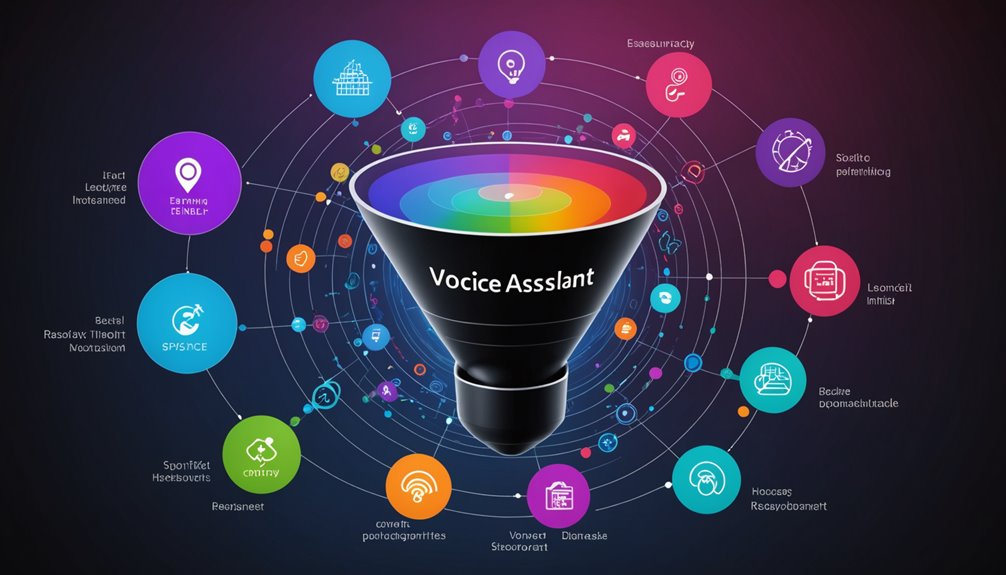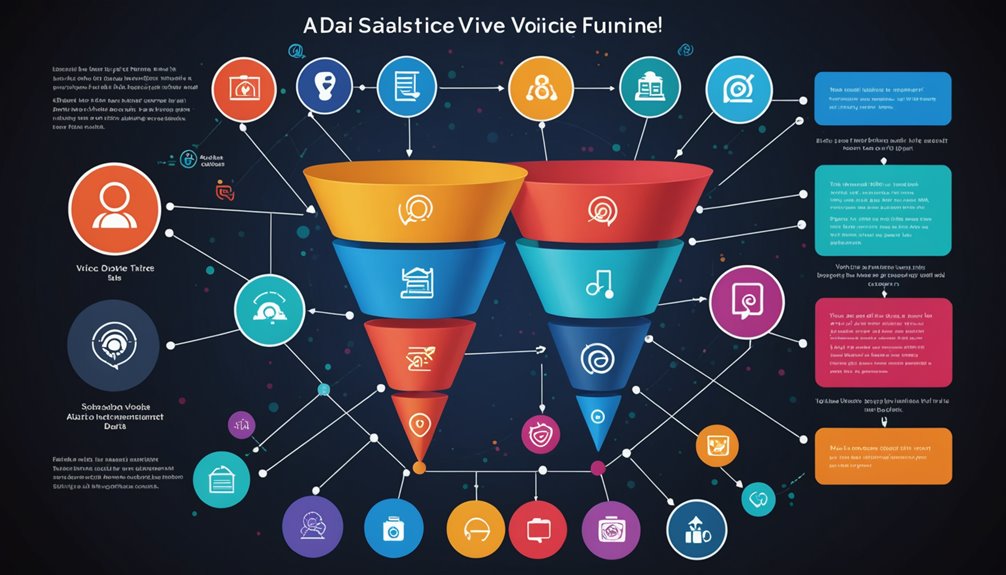Integrating AI voice solutions into your sales funnel involves a strategic process. This begins with evaluating existing sales protocols and pinpointing prime spots for AI intervention. Such technology streamlines operations guarantees brand alignment and broadens multilingual capacities. Subsequent steps involve choosing suitable platforms and developing conversational flows for seamless Customer Relationship Management (CRM) integration without neglecting continuous evaluation and optimization. Utilizing the potential of AI can enrich lead generation, customer interaction, and actual-time lead scoring for a more optimized customer experience. As your grasp of the fullness of this technology strengthens, you’ll begin to unearth its actual capability.
Enhance Sales Processes with Launched AI Voice SolutionsKey Takeaways
- Evaluate existing sales processes to identify suitable AI integration points that can automate tasks and enhance productivity.
- Select AI voice platforms that align with your brand’s identity, tone, and business objectives. Ensure multi-language capability for a wider reach.
- Develop conversational flows and integrate AI voice solutions with your CRM for seamless communication and personalized customer interactions.
- Monitor the performance of AI voice tools, measuring key metrics like conversion rates and customer satisfaction for continuous improvement and optimization.
- Train, test, and refine AI models using high-quality data, ensuring robustness, accent normalization, and practical error-handling mechanisms for best results.
Identifying Key Touchpoints
The integration of AI voice solutions into sales funnels begins with identifying key touchpoints. The initial engagement relies heavily on automated lead generation, where AI tools analyze customer data to identify potential leads. Voice AI, powered by large language models like GPT, enables efficient outreach, while tailored AI-driven messages improve engagement. AI voice bots streamline the lead qualification process, reducing manual effort and ensuring that only high-quality prospects are passed onto sales teams.
AI voice agents handle customer interactions, customizing conversation flows to specific customer needs and providing individualized recommendations. These interactions are underpinned by AI’s capacity to absorb and learn from historical sales data, thereby boosting customer engagement. Feedback and analysis are vital at this stage, with AI collecting customer feedback, analyzing sentiment and intent, and identifying skill gaps in sales teams. Through the use of comprehensive reporting tools, AI can provide valuable insights for optimizing revenue growth, streamlining sales, and enhancing productivity.
The conversion optimization phase involves AI voice bots automating demo scheduling, appointment setting, and sales follow-ups. AI-driven scheduling and follow-ups improve conversion rates and reduce manual effort. AI also streamlines order processing and post-sales support, enhancing customer satisfaction and experience. The performance measurement phase involves a thorough analysis of conversion rates post-AI implementation, providing tangible insights into AI’s impact on sales funnel efficiency. Voice AI technology(powered by large language models like GPT) has significantly evolved, simulating human conversational abilities with advanced algorithms, thereby contributing to the efficiency of sales processes.
Evaluating AI Predictive Dialing
Several critical factors and functionalities are involved in evaluating AI predictive dialing platforms for integration into your sales funnel. The platform’s compatibility with existing CRM systems is an undeniable criterion for guaranteeing seamless workflow. It must also offer capabilities for integration with multiple digital communication channels, allowing omnichannel inbox management for increased efficiency.
A key functionality is real-time lead scoring and prioritization, fueled by AI and ML algorithms. This feature aids in determining the right time to contact leads and optimizing the sales process. Another valuable feature is automated voicemail drop and number reputation management, which helps maintain a professional image while also saving time.
Local caller ID features improve customer engagement by fostering a sense of individuality and familiarity. Meanwhile, built-in AI reply suggestions can speed up response times, further enhancing customer satisfaction and potentially increasing conversion rates by up to 47%.
The chosen platform should align well with your business objectives. After its implementation, it’s crucial to test the AI system thoroughly to identify potential issues. Performance metrics such as conversion rate improvements, decrease in idle time, and improved customer engagement are indicators of successful integration. Implementing AI tools gradually into your sales funnel can help minimize disruptions and smoothen the transition (gradual integration).
Importance of Scalability
In the constantly changing technological landscape, businesses find scalability to be a vital factor in choosing a Voice AI platform. Scalability guarantees that companies can meet growing demands without compromising on quality, enabling them to handle a larger volume of interactions without the need for additional personnel. Significantly, Voice AI can maintain a consistent brand voice across all interactions, which is essential for safeguarding sales operations for the future.
Choosing the right platform that aligns with business requirements and offers scalability is critical. This includes platforms that work as part of a multichannel campaign and integrate with existing systems to improve scale. Able multichannel platforms should support both voice and digital channels and have a unified memory accessible to all channels. Furthermore, the right platform can enhance the efficiency of sales teams by automating time-consuming tasks like lead prioritization and data entry, thus allowing sales agents to focus on more complex customer interactions (AI automation). An added benefit is the ability to leverage predictive analytics to forecast market trends and consumer behaviors, which further optimizes the sales strategy and improves conversion rates.
The long-term benefits of implementing a scalable Voice AI system are substantial. Compared to manual sales calls, voice AI offers a more reliable and consistent approach. Remarkably, it can handle a high volume of interactions without compromising quality, leading to improved conversion rates and revenue generation. Over time, Voice AI can lead to significant cost savings, allowing businesses to grow without the need for additional staff.
Brand Identity Alignment

Establishing a consistent brand identity in this technologically diverse landscape can be a formidable plunge. However, integrating AI voice solutions into your brand strategy can help guarantee brand voice consistency across all platforms and contexts. AI Brand Voice Guides, for instance, are instrumental in maintaining brand voice consistency in content creation and communication.
A one-of-a-kind brand AI voice is more than just a technological feature—it’s a strategic tool for reinforcing brand identity, amplifying brand recognition, and building trust with users. By tailoring AI voices to align with your brand’s values, tone, and identity, you can create a distinctive and recognizable voice that sets your company apart from competitors and provides a memorable brand experience. Furthermore, using AI voice solutions can not only streamline operations but also enhance productivity through automated tasks, making your brand more efficient and effective.
Integrating AI voice solutions into your sales funnel requires strategic planning. Key touchpoints must be identified, and AI voice systems need to be personalized to match the brand’s identity and tone. AI-powered tools can streamline content creation, guarantee genuineness in AI-generated content, and optimize sales funnel conversions, thereby enriching the user experience. Moreover, with the application of AI voices, brands can communicate in multiple languages, significantly expanding their audience reach.
| Consistency Across Platforms | Tailoring AI Voices | Implementation Strategies |
|---|---|---|
| AI Brand Voice Guides guarantee consistency | Personalized AI voices align with brand values | Identify key touchpoints for integration |
| One-of-a-kind AI voices contribute to a unified presence | AI tools replicate the brand voice | Personalize AI systems to match the brand |
| AI maintains consistency in content creation | Unique voices enrich the user experience | Use AI Guides for genuine content |
| AI aligns with brand guidelines | AI voice sets the company apart | AI tools streamline content creation |
| AI identifies brand voice inconsistencies | Consistent voices build trust with users | AI optimizes sales funnel conversions |
Training AI Models
Training AI models is a complex yet crucial component of integrating AI voice solutions into sales funnels. Three main methods are involved: supervised, unsupervised, and semi-supervised learning. Supervised learning, which uses labeled data, is excellent for tasks such as object recognition or sentiment analysis. Unsupervised learning, on the other hand, utilizes unlabeled data to uncover hidden patterns and structures, making it excellent for clustering or anomaly detection. Semi-supervised learning combines these methods, using both labeled and unlabeled data to improve functionality and precision.
Certain practices are essential in the training process. The initial step is data preparation, which involves cleaning, organizing, and formatting data. Hyperparameter tuning follows, adjusting models for peak performance. Cross-validation, which consists of dividing datasets to validate model performance during training, guarantees accurate results. Regularization methods prevent overfitting by penalizing more complex models. Finally, transfer learning saves time by leveraging pre-trained models for new, related tasks. These steps, when implemented correctly, lead to more efficient and precise AI models.
Moreover, AI models, when integrated with sales automation tools, can significantly enhance lead conversion rates and provide insightful customer insights, aiding the sales team in making data-driven decisions.
Defining Conversational Flows

Steering through the domain of conversational flows necessitates a thorough understanding of different key areas. The initial step is mapping interactions, which involves defining conversational scenarios that AI agents will handle. This guarantees the AI is prepared to deliver appropriate responses to a variety of customer inquiries.
Underpinning this is the AI’s ability to comprehend the context of conversations. Leveraging Natural Language Processing (NLP), AI can interpret spoken language accurately, fostering more meaningful and productive interactions. Complementary to this is the concept of intent identification. Natural Language Understanding (NLU) processes data to comprehend what a customer wants, allowing the AI to guide its responses accordingly.
The aim is to create an environment of genuine-time engagement. Ultra-authentic voice AI can provide instantaneous responses, ensuring dynamic and satisfying customer interactions. Additionally, the system should be able to collect customer feedback for analysis. This feedback can help us better understand customer needs and drive the sales strategy.
By utilizing AI, businesses can drastically reduce the risk of missed calls, which can negatively impact customer satisfaction and potentially cause revenue loss.
Furthermore, the integration of an AI-driven system can automate up to 90% of calls, thereby enhancing operational efficiency and providing a strong foundation for business scalability.
Successfully defining conversational flows results in a more streamlined, efficient, and customer-centric sales funnel, which improves business outcomes.
Data Integration and Testing
The process of integrating AI voice solutions into sales funnels necessitates a robust alignment of AI and data, which forms the bedrock for effective decision-making. Implementing extensive testing strategies is essential to guarantee the accuracy and efficiency of AI operations. It is also vital to continuously refine AI voice responses, thereby enhancing the system’s adaptability to dynamic customer interactions and promoting higher conversion rates. Furthermore, the use of AI voice solutions can drastically reduce response times, boosting customer support efficiency and promoting a streamlined shopping experience (reduced response times).
Aligning AI and Data
To fully utilize AI in your sales funnel, you must meticulously align your AI tools with your data. This alignment is a nuanced process that involves data preparation, synchronization, protection, and analysis.
| Process | Importance | Execution |
|---|---|---|
| Data Preparation | Enables accurate AI predictions | Clean, standardize, validate, and update data regularly |
| Data Synchronization | Guarantees unified data access | Use APIs or data connectors, implement data mirroring, and integrate with analytics platforms. |
| Data Protection | Safeguards sensitive data | Employ encryption, conduct security audits, comply with regulations |
| Data Analysis | Monitors and refines AI performance | Utilize key metrics, conduct A/B testing, gather feedback for optimization |
Effective Testing Strategies
Utilizing the power of AI voice solutions in a sales funnel necessitates a thorough and tactical testing approach. This begins with data preparation and validation, guaranteeing high-quality, unbiased data and carefully curated training data sets. Identifying and designing edge cases helps reveal unexpected system behavior while practicing good data hygiene mitigates the risk of “garbage in, garbage out.”.
Functional and integration testing verifies that AI algorithms produce expected outcomes and interact seamlessly with other software components. Testing system robustness against different inputs and scenarios verifies reliability, while effective error-handling mechanisms bolster system resilience.
Usability testing and feedback focus on the conversational user experience and natural language understanding. Feedback loops and customer feedback analysis are vital to continuously refining AI voice solutions. Performance metrics and evaluation, such as monitoring KPIs and conversion rates and conducting ROI analysis, provide insights into customer behavior and preferences and the financial impact of AI voice solutions. This creates a solid foundation for continuous improvement, guaranteeing the effectiveness of AI voice solutions in the sales funnel.
Refining Voice AI Responses
Refinement of voice AI responses is a meticulous process that hinges on the strategic integration and testing of data. Internal customer interactions, external datasets, and synthetic data are instrumental in fine-tuning the system. Diversity in training samples and accent normalization contribute considerably to refining responses.
Integrating outside data sources such as CRM and open-source datasets can improve the system’s performance. Normalizing data formats for consistency is essential, as is guaranteeing data security and regular updates.
Implementing data augmentation, transfer learning, hyperparameter tuning, noise reduction filters, and automated gain control techniques can improve the robustness of the AI model against varied authentic-world scenarios.
Domain-specific accuracy, a key determinant of the system’s effectiveness, can be achieved by personalizing AI scenarios, using industry-specific keywords, and integrating relevant industry knowledge. Continuous learning and regular performance evaluation are essential to maintaining high accuracy and reliability. The freedom to refine and adapt the system guarantees its relevance in the constantly changing business landscape, making it an indispensable tool in the sales funnel.
Impact Areas for Voice AI

Integrating voice AI into sales funnels can have a wide range of impact areas. The technology markedly increases sales efficiency by automating and streamlining processes, such as dialing and cold calling. It minimizes manual data entry, reduces errors, and frees sales teams to focus on selling rather than administrative tasks.
Voice AI also improves the customer experience. By customizing interactions, reducing wait times, and adapting to distinct customer preferences, customers feel more engaged and valued. This increased satisfaction often translates to improved customer loyalty.
Furthermore, Voice AI provides valuable data-driven insights that can be utilized to refine sales strategies. It can offer invaluable insights into customer behavior, suggest improvements in cold-calling strategies, and aid in precise customer segmentation and targeting. These AI-driven recommendations help elevate conversion rates.
Finally, Voice AI technology increases conversion rates by improving sales funnel efficiency. It qualifies leads, tailors marketing messaging, predicts future sales trends, and integrates AI across different sales channels. This results in improved ROI and comprehensive sales performance, demonstrating the groundbreaking potential of integrating Voice AI into sales funnels.
Seamless Integration Techniques
Achieving smooth incorporation of Voice AI into sales funnels requires a strategic and systematic approach. This begins with evaluating existing sales processes to identify key points where AI voice solutions can be most effective. The selection of relevant AI platforms aligning with business objectives is vital, as is the development of conversational flows and integration with CRM systems for smooth communication.
Tailoring AI solutions involves aligning with brand identity and training AI models using pertinent data to produce accurate responses. Incorporating company-specific contextual data improves individualization, while feedback loops and regular updates guarantee continuous enhancement.
Technical compatibility is another fundamental aspect of smooth incorporation. This includes system integration with existing sales tools, API compatibility, robust security measures, scalability, and ongoing maintenance and support.
Finally, monitoring and optimization play a pivotal role. Key performance indicators must be identified and monitored, and data analysis provides insights into customer behavior and preferences. Continuous optimization and strategic adjustments based on these insights guarantee that AI solutions remain practical and relevant. This thorough approach to smooth incorporation fosters a sense of freedom and autonomy, enabling businesses to utilize Voice AI to its full potential.
Real-time Analytics Benefits

Utilizing the power of live analytics in AI voice solutions can considerably improve the efficiency and effectiveness of sales funnels. Through predictive insights, genuine-time analytics can forecast customer behavior based on historical data and trends. This not only aids in proactive decision-making but also optimizes resource allocation.
Moreover, customer interaction analysis is enhanced to a new level. With AI-powered speech recognition, phone conversations are transcribed and analyzed for key insights. Sentiment analysis and genuine-time data visualizations aid in understanding customer emotions, engagement, and areas requiring added attention.
Performance optimization is another significant benefit. Genuine-time analytics in voice AI can identify areas for improvement, inform sales strategies, and increase appointment rates. Advanced analytics further refine sales pitches and effectively handle objections.
Finally, genuine-time analytics enable strategic decision-making. They identify predictive trends and opportunities, highlight best practices in sales interactions, and improve forecasting accuracy. This data-driven approach provides practical insights for optimizing sales processes, fostering an environment of strategic growth and freedom in decision-making. Consequently, genuine-time analytics become a crucial part of a successful sales funnel integration.
Embracing Ultra-Realistic Voice AI
Shifting into the domain of ultra-authentic voice AI presents businesses with a myriad of opportunities to improve their sales funnels. This state-of-the-art technology not only fosters improved customer experiences but also drives efficiency and cost savings.
The richness of AI voices elevates customer engagement, thereby increasing satisfaction and loyalty. It also automates routine voice tasks, freeing up personnel for more valuable endeavors. Individualized and expressive voice interactions can lead to higher conversion rates, while multi-language support broadens your brand’s global outreach.
Integrating ultra-realistic voice AI requires strategic planning. APIs like Fliki’s Text to Speech allow smooth incorporation into applications and workflows. Voice parameters such as dialect, speed, and emotion can be adjusted to align with the brand’s identity. Security is another vital aspect, with solutions like PlayHT offering secure and private voice generations.
The use cases for ultra-realistic voice AI are vast, ranging from podcasts, e-learning modules, IVR systems, and conversational assistants to gaming. With advanced machine learning, voice cloning, and adjustable parameters, the technology guarantees consistent branding, dynamic content, and natural speech, thereby revolutionizing the sales funnel experience.
Key Performance Indicators

Navigating through the realm of AI voice solutions requires a sharp understanding of key performance indicators (KPIs). These metrics shape the success of your AI voice agent integration, providing insights that drive operational efficiency and customer satisfaction.
A vital KPI is the conversion rate, which reflects the effectiveness of AI voice agents in turning leads into customers. This can be further broken down into distinct stages within the sales funnel, giving a granular view of where the AI solution adds the most value. Other KPIs related to sales include average order value and customer satisfaction, both of which can be enhanced through the customization capabilities of AI voice agents.
Operational efficiency and compliance KPIs are similarly essential. They highlight the time and cost savings achieved through automation, along with ensuring adherence to compliance standards. Agent performance and quality of interactions, too, serve as significant KPIs for optimizing the use of personnel and AI resources.
Lastly, continuous monitoring, feedback integration, and data synchronization are instrumental for refining strategies, ensuring seamless operation, and enhancing AI effectiveness. By highlighting these KPIs, you utilize AI voice solutions to their fullest potential, releasing unparalleled freedom in your sales operations.
Data Analysis and Quality Assurance
Data analysis and quality assurance are pivotal in integrating AI voice solutions into sales funnels. Expert interpretation of sales interaction data can provide insights to improve the decision-making process while ensuring call quality standards can significantly enhance user experience. This combination of strategic data use and rigorous quality control forms the backbone of an effective AI voice solution in sales.
Interpreting Sales Interaction Data
Data analysis and quality assurance play pivotal roles in gaining a thorough understanding of sales interactions. This involves utilizing AI tools to automatically collect and analyze sales interaction data, enabling a complete grasp of customer feedback and needs. Moreover, AI-driven analytics can track sales performance and customer engagement metrics, providing an accurate insight into the sales landscape.
Data analysis techniques such as AI-powered data analysis can identify key sales trends and opportunities. AI also assists in scoring leads based on interaction data, predicting conversion potential, and analyzing customer sentiment. These techniques offer an informed, predictive view of the sales landscape, aiding in strategic decision-making.
Quality assurance measures are similarly crucial. AI-driven tools monitor sales interactions, guaranteeing their effectiveness and relevance. Regular audits of AI-generated sales interaction data ensure accuracy, while AI-powered speech analytics assess the quality of sales calls. AI’s ability to detect anomalies in sales interaction data additionally strengthens this quality assurance process, securing a high standard of customer interaction.
Ensuring Call Quality Standards
With the growing significance of customer experience in the sales process, guaranteeing call quality standards through data analysis and quality assurance has become crucial. This process involves measuring key call quality metrics like Mean Opinion Score (MOS) and Average Handle Time (AHT) to evaluate performance. AI-powered feedback tools provide authentic-time analysis, facilitating continuous improvement. Integrating AI insights with customer feedback fosters a holistic understanding of the customer experience, preparing the groundwork for clear quality goals and automated call analysis.
Automating call scoring and transcription improves quality assurance processes, eradicates personal bias, and expedites analysis. Identifying trends and patterns through data analysis facilitates the development of proactive solutions and guarantees a system for ongoing feedback.
AI-driven analytics help analyze customer sentiment and predict future behaviors, optimizing sales and improving customer experience. Automated call routing guarantees efficient service delivery, while integration with CRM systems and workforce management tools optimizes operational efficiency.
Lastly, make sure that the AI platforms are scalable, flexible, and can handle diverse data sources. Compliance is key, and AI should be used to detect and redact sensitive data automatically. Fundamentally, guaranteeing call quality standards is a dynamic process that requires constant monitoring and improvement using AI.
The Future of Voice AI

The landscape of Voice AI technology is rapidly evolving, pushing the boundaries of individual AI interaction and offering a glimpse into a future where voice-enabled experiences become the norm. As AI models integrate with Large Language Models (LLMs), they improve call summaries and authentic-time translation, providing valuable cues for sales teams. Simultaneously, the rise of generative voice advancements transforms Text-To-Speech (TTS) technology, creating more lifelike voices for richer user experiences.
The market potential is promising, with anticipated growth approximately fourfold due to improvements in latency, tonality, and responsiveness. Successful voice companies focus on vertical apps, particularly in healthcare and hospitality. Additionally, 72% of respondents anticipate widespread adoption of voice-enabled experiences within one to five years, signaling a shift towards digital transformation.
Looking to the future, latent acoustic representation (LAR) and tokenized speech models are altering the tech landscape, delivering higher-quality outputs and more accurate results. However, these advancements come with challenges, necessitating further research and innovation in the field. With these developments, Voice AI is set to transform sales strategies, improving performance consistency and scalability.
Frequently Asked Questions
What are the costs associated with Integrating AI Voice Solutions into my sales funnel?
Implementing AI voice solutions into your sales funnel involves initial setup, development, and integration costs. Other expenses include regular maintenance, software updates, technical support, and potential subscription fees. Costs vary depending on business size and solution complexity.
How Can AI Voice Solutions Be Integrated With Non-CRM Platforms?
AI voice solutions can be seamlessly integrated with non-CRM platforms such as telephony, payment gateways, messaging platforms, and analytics tools, enhancing functionalities like genuine-time call routing, automated payments, multichannel engagement, and data-driven decisions.
Are There Specific Industrmultichannelnefit More From AI Voice Solutions?
Yes, specific industries, such as banking, telecommunications, hospitality, retail, and sales, significantly benefit from AI voice solutions due to improved customer support, tailored services, streamlined processes, and valuable data-driven insights.
What Are Some Common Challenges Faced During the Integration of AI Voice Solutions?
Common challenges in integrating AI voice solutions include managing language diversity, complying with regional regulations, handling conversational dynamics, ensuring high-quality speech recognition, and safeguarding data privacy during immersion with existing business systems and processes.
How Does AI Voice Technology Handle Regional Accents or Languages Other Than English?
AI voice technology often struggles with regional accents due to distinct pronunciations and cultural influences. However, diverse training data, advanced algorithms, and personal expertise can significantly improve the handling of these accents.
Conclusion
The integration of AI voice solutions into the sales funnel marks a groundbreaking epoch in digital marketing. This metamorphosis is not merely a trend but an emphatic shift towards a more individualized, intuitive, and efficient customer experience. Leveraging this cutting-edge technology requires careful planning, strategic alignment, and continuous monitoring. With its potential to transform customer engagement, voice AI is indeed the tour de force in the rapidly evolving digital marketplace.

Erik Remmel is a co-founder of Launched, a platform that helps businesses grow through AI-powered marketing, automation, and lead generation. He focuses on building scalable systems that convert cold leads into customers while streamlining operations with smart, AI-driven workflows.

